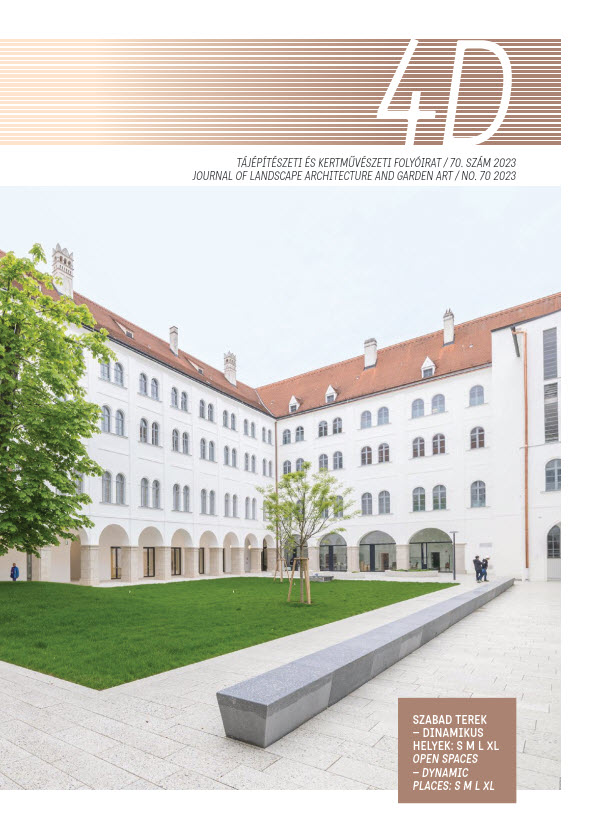The challenges of preserving our modernist public parks
DOI:
https://doi.org/10.36249/4d.70.4688Keywords:
modern public park, composition, concept, ecological and social sustainability, contemporary design principlesAbstract
Among the projects of the 20th century modern landscape architecture, there are some works that deserve to be pre-served as an integral part of the garden heritage. A world-wide inventory and evaluation of this landscape heritage is currently underway to identify those works that best represent the landscape architecture of the period. How can these works be restored in a way that meets today's ecological and social sustainability requirements without losing their original character? In the intensively used public parks presented in this article, complete reconstruction is generally not feasible, but the scale of the transformation is a central issue. International experi-ence shows how unclear the criteria for aspects of selecting works to be preserved. For the time being, it is still often a subjective judgement, even within the professional community, whether the intervention used in the renovation process changes the composition of the original work. The renewal of any historic park and garden from any era must address sustainability, usually primarily from an ecological perspective. However, the contemporary regeneration of public parks and urban open spaces from the modern era, which are still intensively used today, is further complicated by the need for contemporary recrea-tional functions to be incorporated during the renovation and the application of universal design principles, which present additional challenges to integrate. Social sustainability is a strong requirement at these renovations.In this article, we analyse four modern public parks that were been renewed in the last 25 years or are in the process revitalization. In our country today, there is still no professional consensus as to which modern public parks can be considered valuable and worth preserving for the future - if not through complete reconstruction, then by carefully preserving the basic concept and compositional principles. The guiding principle in the selection of the public parks presented in this article was that they should be of different periods and have different recreational functions, with different challenges in their restoration.
References
Bakay Eszter (2012): Lakótelepek szabad-térépítészete 1945-1990 között Budapest példáján, doktori disszertáció, BCE, Budapest
Bakay Eszter – Varró Dorottya (2016): Late modern park high above the city – space composition of the 50 years old Jubileum Park in Budapest. In: Zachariasz, Agata – Sykta, Izabela – Kowalski, Przemyslaw (ed.) Teka Komisji Urbanistyke I Architektury, TOM XLIV. Kraków, Lengyelország. Polska Akademia Nauk, Kraków, Lengyelország, pp. 181–186.
Birnbaum, Charles (2012-14): Modern Landscapes: Transition + Transformation Princeton Architectural Press, USA
Csepely-Knorr Luca (2011): Korai modern szabadtérépítészet (A közparktervezés elmélet fejlődése az 1930-as évek végéig), doktori disszertáció, BCE, Budapest
Green, Jared: Are modernist landscapes worth saving? https://dirt.asla.org/2017/05/22/are-modernist-landscapes-worth-saving/ (2017.05.22) [2023.10.20.]
Grunert, Heino (2013): Stadtentwicklung durch Gartenschauen am Beispiel des westlichen Hamburger Wallrings – in: Grün modern- Gärten un dParks der 1950er bis 1970er Jahre Bund Heimat und Umweltder Deutschland (BHU) ISBN 978 3 925374 35 7 pp 47-54
Hauxner, Malene (2003): Open to the sky, The Danish Architectural Press, Dánia
https://www.wiesbaden.de/microsite/stadtlexikon/a-z/reisinger-und-herbert-anlagen.php [2023.10.15]
Kakas Réka 2016: Kertészeti kiállítások az 1950-es és '60-as évekből és hatásuk a Budapest közparkjaira, szakdolgozat, SZIE, Budapest
Meyer, Elisabeth (2005): The Grounds of Modern Landscape Architecture, in: Site Matters, Routledge, New York, ISBN9780203997963
Michel, Martina Claire: Reisinger- und Herbert- Anlagen
Modernist landscape considered- a panel discussion https://www.youtube.com/watch?v=SVPV6YUHd-4 [2023. 10.20.]
Nándori E. (2006): Sztálinváros zöldfelü-leteinek története, diplomamunka, BCE, Budapest15 Bakay Eszter (2013): Retroterek, retroparkok, TERC, Budapest, ISBN:978 963 9968 94 3
Skyline Park Design Threatened by Renovation https://www.tclf.org/content/skyline-park-0 (2002. 09. 15.) [2023.10.20.]
Takács Katalin – Kubik Emese – Almási Balázs (2021): A modern mozgalom hajnalán: a budapesti Szent István park kertművészeti elemzése = At the dawn of the modern movement: a historical analysis of the Szent István park in Budapest, 4D: 60 pp. 18-33. 16 p.
Treib, Marc (1993): Axioms for a modern landscape architecture in: Modern landscape architecture: a critical review, Cambridge, Mass.: MIT Press, pp 36-67.
Downloads
Published
Issue
Section
License
Copyright (c) 2023 Karlócainé Bakay Eszter, Gergely Antal, Reith Anita

This work is licensed under a Creative Commons Attribution-NonCommercial-NoDerivatives 4.0 International License.
A folyóirat Open Access (Gold). Cikkeire a Creative Commons 4.0 standard licenc alábbi típusa vonatkozik: CC-BY-NC-ND-4.0. Ennek értelmében a mű szabadon másolható, terjeszthető, bemutatható és előadható, azonban nem használható fel kereskedelmi célokra (NC), továbbá nem módosítható és nem készíthető belőle átdolgozás, származékos mű (ND). A licenc alapján a szerző vagy a jogosult által meghatározott módon fel kell tüntetni a szerző nevét és a szerzői mű címét (BY).






 intézetigazgató: Dr. Fekete Albert
intézetigazgató: Dr. Fekete Albert


